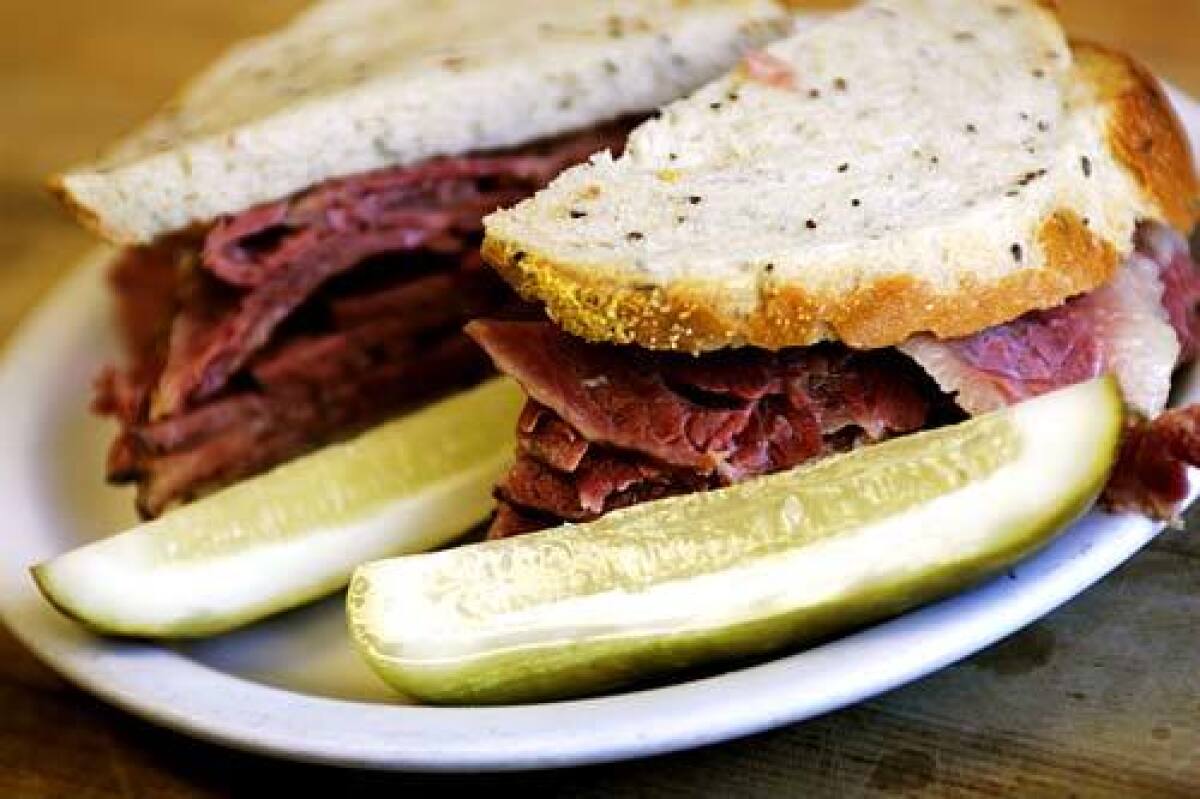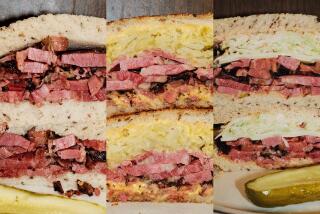‘Save the Deli: In Search of Perfect Pastrami, Crusty Rye, and the Heart of Jewish Delicatessen’ by David Sax

Save the Deli
In Search of Perfect Pastrami, Crusty Rye, and the Heart of Jewish Delicatessen
David Sax
Houghton Mifflin Harcourt: 320 pp., $24
The wandering of the Jews is frozen in the marble of the corned beef on rye. The fall of the Temple, the exile, life in the ghetto, reliance on the cheapest meat and the ensuing need to tenderize and smoke and spice, the crossing to the New World -- it all culminates in the towering sandwich you find at the Carnegie in New York, Junior’s in L.A., Manny’s in Chicago. Every deli is a synagogue. What remained when the kingdom was smashed and the faithful sent a-wandering.
In his deeply satisfying new book “Save the Deli: In Search of Perfect Pastrami, Crusty Rye, and the Heart of Jewish Delicatessen,” David Sax sets out to tell this story one city, one deli, one tradition at a time, traveling from New York to San Francisco to Los Angeles, speaking to deli men, eating smoked meat, working as a cutter at Katz’s on Houston Street (“Like snowflakes, no two pastramis are exactly alike, sometimes the flesh would be buttery soft, with very few sinews to impede my carving, but often I’d cut through a maze of tissue”), tasting and kvetching and chronicling the state of the cuisine, all this activity set against a dread premonition -- that the deli is going away, and the long run is over. “Across North America . . . Jewish delicatessens are disappearing faster than chicken fingers at a bar mitzvah buffet,” he writes.
Sax chronicles the demise of the deli: the skyrocketing cost of rent in big cities, the dispersal of American Jews, the climbing cost of meats traditionally used by delis (driven by the popularity of Texas barbecue) and, most important, the lack of culinary interest from next-generation Jews.
This wonderful book is, in other words, both memorial and call to arms, a shofar blast meant to summon the far-flung back to the Temple remnants. “I hope to open your hearts to the same unrestrained love of Jewish delicatessen that I feel . . . and then subsequently fill those hearts with cholesterol.”
Sax is actually operating in a grand tradition of Jewish reporting: that of Benjamin Tudela, the 12th century Jewish traveler wandering the Earth, observing and recording the state of Hebrews everywhere. Sax wants to know where they are, how it is, and what they’re serving, food long having been a kind of barometer on Jewish well-being. In the early days of the Second World War, for example, when Polish Jews wanted to tell their American cousins how they were faring under the Nazis, they wrote, “We eat as on Yom Kippur.”
Sax visited Protzel’s in St. Louis; the New York Deli News in Denver, where John Elway once ordered a pastrami on white with mayo; Kosher on the Go in Salt Lake City; and the Kosher Cajun New York Deli and Grocery in New Orleans, among many others. In the end, he decides the best deli town in the U.S. (“brace yourselves, New York,”) is Los Angeles, where he sits with Mel Brooks at Junior’s in Westwood.
All the while, Sax lingers on the homey feel of the deli, a port in the stormy world, where, long before the birth of modern Israel, a Jew could find solace. “The air is thick with the warm vapor of boiling chickens,” he writes of Gottlieb’s in Williamsburg, Brooklyn. “A gentle clamor fills the ears; the clang of cutlery, a few gulps of liquid, the sizzle of fat on a hot surface.”
It’s a trip that suggests a Proust-like mission, in which the writer, by gorging his way around the map -- “I managed to haul my ever-expanding ass across the entire continental United States, eating at up to four delicatessens every single day” -- tries to recapture the joy of his first childhood meals in the storied delis of Montreal. “The meat is a wild mess of carnivorous beauty,” he writes of a sandwich at Schwartz’s. “At parts black and sticky, at points a light rose, mostly a meaty maroon.”
The book is organized by region, each section opening with a quick history of the local Jews, a kind of encyclopedia entry that has the not unpleasant effect of attaching the story of the Hebrews to the story of their delis, these being the wild and intricate flowers thrown out by the community when the soil is right, the air is right, and the bees buzz around the hive. He speaks with special élan of New York in the first decades of the last century, when, each year, new delis opened as grand new hotels now open each season in Vegas. “Katz’s, Jacob Bronfman’s, Theodor Krainin’s, Schmulka Bernstein’s on Essex, each growing larger and more lavish than their predecessors,” he writes. “Chief among these were the holy trio of corned beef, pastrami and pickled tongue, followed closely by roast brisket, beef salami, and beef baloney.”
For historical reasons, Jews are obsessed with the fall of temples, and the aftermath of Diaspora, memory and pain. Two such disasters echo through this book: the fall of the 2nd Avenue Deli, which went down in a moment, like a collapsing star, leaving a black hole on the Lower East Side of Manhattan (“The two-foot-high Yiddish- inspired letters of the . . . sign lay dismantled on the sidewalk, like battlefield casualties in a Civil War photograph”) and the fall of the Rascal House in North Miami Beach, the true promised land of the Jews, which succumbed as glacially and picturesquely as the Ottoman Empire. “When I heard the news in late 2006,” writes Sax, “I was crushed.”
Despite page after page of gluttonous joy, this is, in fact, a melancholy book, a sepia snapshot of our grandparents’ world as it vanishes. To paraphrase the old blues tune, you don’t miss your kreplach till it’s gone.
Cohen is the author of “Sweet and Low,” “Tough Jews,” “The Avengers,” “The Record Men,” “Lake Effect” and, most recently, “Israel Is Real: An Obsessive Quest to Understand the Jewish Nation and Its History.”
More to Read
The biggest entertainment stories
Get our big stories about Hollywood, film, television, music, arts, culture and more right in your inbox as soon as they publish.
You may occasionally receive promotional content from the Los Angeles Times.










